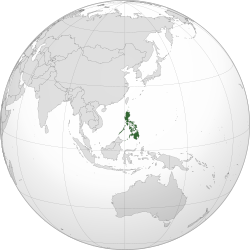Philippine Republic | |
|---|---|
| Motto: Libertad, Justicia e Igualidad "Liberty, Justice and Equality" | |
| Anthem: Lupang Hinirang "Chosen Land" | |
 Location of the Philippines in Southeast Asia (green) | |
| Capital | Malolos 14°50′N 120°48′E / 14.833°N 120.800°E |
| Largest city | Manila 14°20′N 120°58′E / 14.333°N 120.967°E |
| Official languages | None at the federal level |
| Recognized regional languages | |
| National language | |
| Ethnic groups (2010) | |
| Religion (2015) |
|
| Demonym(s) |
|
| Government | Federal semi-presidential republic |
| Isko Moreno | |
| Francisco Pangilinan | |
| Risa Hontiveros | |
| Leila de Lima | |
| Alejandro Gesmundo | |
| Legislature | National Assembly |
| Senate | |
| Congress of Deputies | |
| Independence from Spain | |
| June 12, 1898 | |
| January 21, 1899 | |
| Area | |
• Total | 300,000 km2 (120,000 sq mi) (72nd) |
• Water (%) | 0.61% (inland waters) |
| 298,170 km2 (115,120 sq mi) | |
| Population | |
• 2023 census | 57,035,043 |
• Density | 336/km2 (870.2/sq mi) (47th) |
| GDP (PPP) | 2023 estimate |
• Total | |
• Per capita | |
| GDP (nominal) | 2023 estimate |
• Total | |
• Per capita | |
| Gini (2018) | medium inequality |
| HDI (2021) | very high (15th) |
| Currency | Philippine peso (₱) (PHP) |
| Time zone | UTC+08:00 (FST) |
| Date format | mm/dd/yyyy |
| Drives on | right |
| Calling code | +63 |
| ISO 3166 code | PH |
| Internet TLD | .fp |

